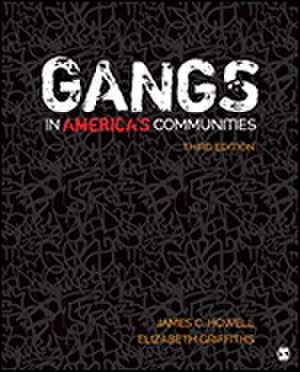Gangs in America's Communities
Autor James C. Howell, Elizabeth A. Griffithsen Limba Engleză Paperback – 30 apr 2018
Preț: 538.03 lei
Preț vechi: 727.07 lei
-26% Nou
102.97€ • 107.10$ • 85.00£
Carte disponibilă
Livrare economică 25 martie-08 aprilie
Livrare express 08-14 martie pentru 33.77 lei
Specificații
ISBN-10: 1544300220
Pagini: 392
Dimensiuni: 187 x 232 x 24 mm
Greutate: 0.61 kg
Ediția:Third
Editura: SAGE Publications
Colecția Sage Publications, Inc
Locul publicării:Thousand Oaks, United States
Recenzii
“[Gangs in America's Communities] provides a good overview of street gangs in the United States. Its coverage is extensive on this topic in terms of the history of gangs in the United States, theoretical explanations for gang formation and gang involvement among individual youth. The coverage of gang prevention, intervention, and suppression programming is also thorough…”
“A very good overview of gangs and helps to begin the discussion about definitions and theory for students.”
Cuprins
Acknowledgments
About the authors
Chapter 1: History of Gangs in the United States
Street Gang Emergence in the Northeast
Street Gang Emergence in the Midwest
Street Gang Emergence in the West Region
Street Gang Emergence in the South
Another Wave of Immigrant Groups
The Institutionalization of Street Gangs
Chapter 2: Myths and Realities of Youth Gangs
Consideration of Key Myths About Gangs
Chapter 3: Defining Gangs and Gang Members
Defining Gangs
Typologies of Gang Members and Gang Structures
Gang Subculture
Gang Graffiti
A European Gang Definition
A Recommended Gang Definition for Practical Purposes
Defining Gang Members
Demographic Characteristics of U.S. Gangs and Gang Members
Chapter 4: General Macro-Level Theories and Modern-Day Applications
The Chicago School and Development of the Social Disorganization Perspective
Application of Social Disorganization Theory to Gangs
A General Explanation of Gang Origins, Expansion, and Violence
Other Macro-Level Theories
Chapter 5: Micro-Level Theories: Developmental Life-Course Pathways and Other Micro-Level Explanations for Gang Involvement
Location of Gang Membership in Developmental Pathways
Developmental Theories
An Illustration of the Life-Course Model of Gang Involvement
A Broad Developmental Gang Theory
The Gang Joining Process
“The Digital Street”: Gangs on Social Media
Apex of Gang Member Criminal Activity
Long-Term Impact of Gang Membership on Participants
Desistance From Gang Membership
Other Micro-Level Gang Theories
Chapter 6: Girls and Gangs
Females in Early Gang Studies
Modern-Day Studies of Female Gang Members
Level of Female Gang Involvement and Seriousness of Crimes
The Question of Increasing Female Gang Involvement
The Importance of Gang Gender Composition
Female Associates of Gang Members: Risks and ReVictimization
Girls’ Unique Treatment Needs and Implications for Prevention and Treatment
Chapter 7: National Gang Problem Trends: 1996 to 2012
An Overview of Nationwide Gang Activity in the Modern Era
Nationally Reported Youth Gang Activity From the Mid-1990s
Patterns in U.S. Localities’ Histories of Gang Activity
Patterns of Gang Presence in Larger Cities
Modal Cities
Regional Variations in Gang Presence
Explaining the Emergence, Persistence, and Decline of Gang Activity
Chapter 8: Urban Gangs and Violence
The Intensity of Gangs in Cities
Serious Gang Problem Trends
A National Perspective of Gang Structures
Key Structural Features of Violent Gangs Nationwide
A Social Network Approach to Gang Cohesion
Gunshot Injury Risk Associated with Social Networks
Case Studies of Gang Problems in Large Cities
Contextual Characteristics That Contribute to Serious Gang Problems
Chapter 9: What Works: Prevention
Risk-Focused, Data-Driven, and Research-Based Gang Prevention
A Framework for Prevention and Early Intervention
Building a Continuum of Effective Delinquency Prevention and Early-Intervention Programs
Chapter 10: What Works: Intervention and Suppression
Evidence-Based Gang Programs
Promising Gang Programs
The Utility of Gang Intelligence Databases
The Comprehensive, Community-Wide Gang Program Model
The Evidence-Based Comprehensive Gang Program Model
Project Safe Neighborhoods
Glossary
References
Index
Notă biografică
Dr. James C. (Buddy) Howell is a Senior Research Associate with the National Gang Center, in Tallahassee, Florida, where he has worked for over twenty years. He formerly worked at the U.S. Department of Justice for 23 years, mostly as director of research and program development in the Office of Juvenile Justice and Delinquency Prevention. He has published over 50 works on youth and street gangs, and a similar number on juvenile justice and delinquency prevention, and seven books on both topics. His gang publication topics include street gang history; gang homicides; drug trafficking; gangs in schools; hybrid gangs; myths about gangs; risk factors; gang problem trends; gang history in the United States; and what works in preventing gang activity, combating gangs, and reducing gang crime. He is very active in helping states and localities reform their juvenile justice systems and use evidence-based programs, and in working with these entities to address youth gang problems in a balanced approach.
Descriere
New to the Third Edition:
- A series of new case studies document the evolution of numerous gangs in large cities, including the community aspect, evolutionary nature, and how cities influence levels of violence.
- New discussions highlighting the role of social media, insights into how gangs use it to recruit members, and the response from law enforcement.
- Current nationwide gang trends are discussed to encourage you to analyze and interpret the most recent statistics for which representative data is available.
- Updated macro and micro gang theories enable you to explore a recent encapsulation of leading developmental models.
- New discussions around female gang members offer you potentially effective programs for discouraging females from joining gangs—along with highly regarded delinquency prevention and reduction programs that have the potency to be effective in reducing gang crimes among young women.
- A comprehensive gang prevention, intervention, and suppression program in Multnomah County, Oregon shows how theory was successfully applied to reduce gang activity in a local community.
- New research on “gang structures” and their rates of crime illustrate the connections between violent crimes and the amount of violent offenders within a gang.
- Additional discussion of distinguishing features (e.g., typologies) of major gangs, and numerous examples of gang symbols, tattoos, and graffiti has been added to help readers identify and differentiate various types of gangs.
